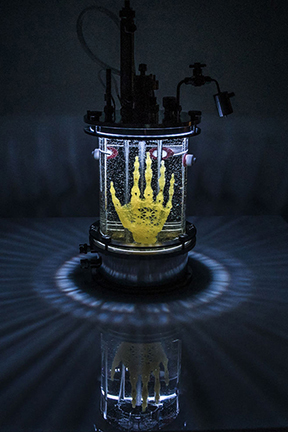Bioprinting
The New Generation of 3D Printing

“File:Regenerative Reliquary by Amy Karle 2016 bioart sculpture.jpg” by LaughingAlbatross is marked with CC BY 4.0.
Printing started with pasting words or images onto paper in 2D. However, new printers have been developed and put to use to go beyond the second dimension. Recently, 3D printers have been trending in many industries. The reason is due to the number of uses and the many types there are. Surprisingly, artificial human organs and body parts are being produced at this moment.
Bioprinting
Bioprinting is a new frontier of 3D printing that has recently been trending. Bioprinting has allowed scientists to manufacture living tissues, blood, and possibly whole organs. Due to the complexity of the structure of cells and tissues, the amount of time it takes to produce items from bioprinting is quite a long time. Bioprinting has many advantages that outweigh the disadvantages.
Bioprinters use a special ink called “bio-ink.” This bio-ink comes from a long process. As you may know, different body parts have different cells. For example, your skin has skin cells, and your kidney has kidney cells. Anyways, cells are then taken from a patient and placed into an incubator, which allows the cells to cultivate. After the cells have been cultivated, the cells are taken out and used for bioprinting.
Bioprinting works somewhat like an ordinary 3D printer. The difference being the product of a bioprinter is a living organism. Cells are then printed out layer by layer, just like a 3D printer. This process takes several hours due to how precise the machine must be. Generally, the cells are tiny, so many bioprinters add a synthetic adhesive that cells can grow on.
Every year, over a hundred thousand Americans are on waiting lists for organs, and those that get organs may have side effects. This shows that change is needed, and scientists need to create an alternative to organ transplants (the organs coming from someone else). This tool has the possibility of changing many lives and getting rid of waiting lists for organs. Bioprinting continues to evolve so it becomes more effective and has better outcomes.
RELATED STORIES:
- https://www.science.org.au/curious/people-medicine/bioprinting
- https://www.allevi3d.com/what-is-3d-bioprinting/
- https://www.frontiersin.org/articles/10.3389/fmech.2020.589171/full
- https://www.cellink.com/blog/bioprinting-explained-simply/
- https://www.nature.com/articles/nbt.2958
TAKE ACTION:










